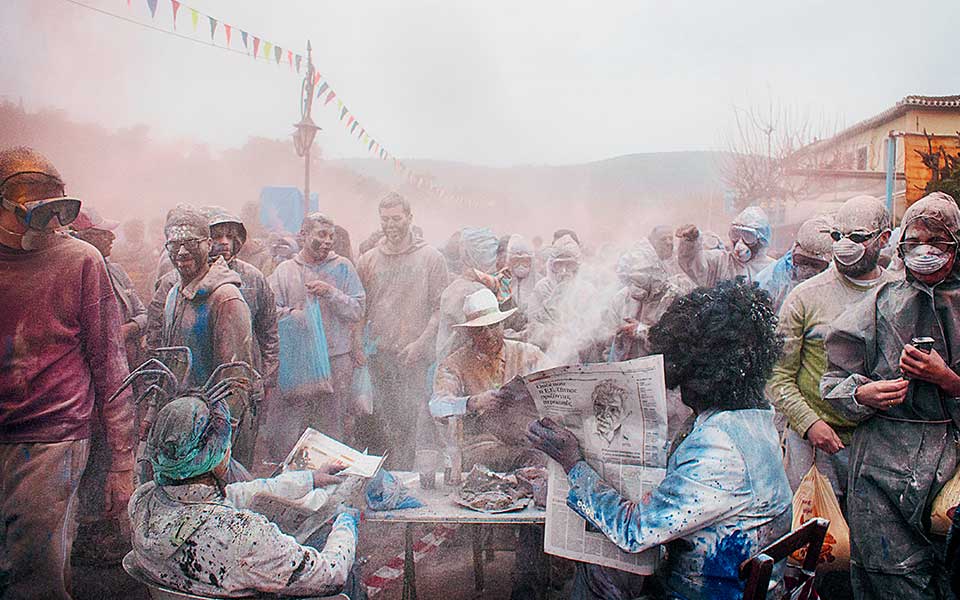Galaxidi – Flour Wars
In Galaxidi flour is a vital ingredient of Clean Monday. The local Alevromoutzouromata (literally meaning “flour smearings”) is a unique custom in Greece, one which is thought to have been brought to Galaxidi by sailors either from Sicily or India, and which represents the pinnacle of Carnival celebrations in the wider area.
On Clean Monday the ordinarily quiet and serene harbor of Galaxidi becomes the setting for high-spirited mayhem. Residents and visitors don old clothes, arm themselves with bags flour and engage in an all out flour-flinging war.
In recent years, many have taken to adding coloring to the flour; donning gas masks for protection, they throw themselves into the event with childlike glee. In the evening, as the celebration winds down, many wash off with a bracing dip in the sea.
If you’re a first-timer or simply prefer to stay out of the line of fire, stick to the right side of the harbor in Pera Panta, a pretty promenade that leads to the statue of the Wife of the Seafarer.
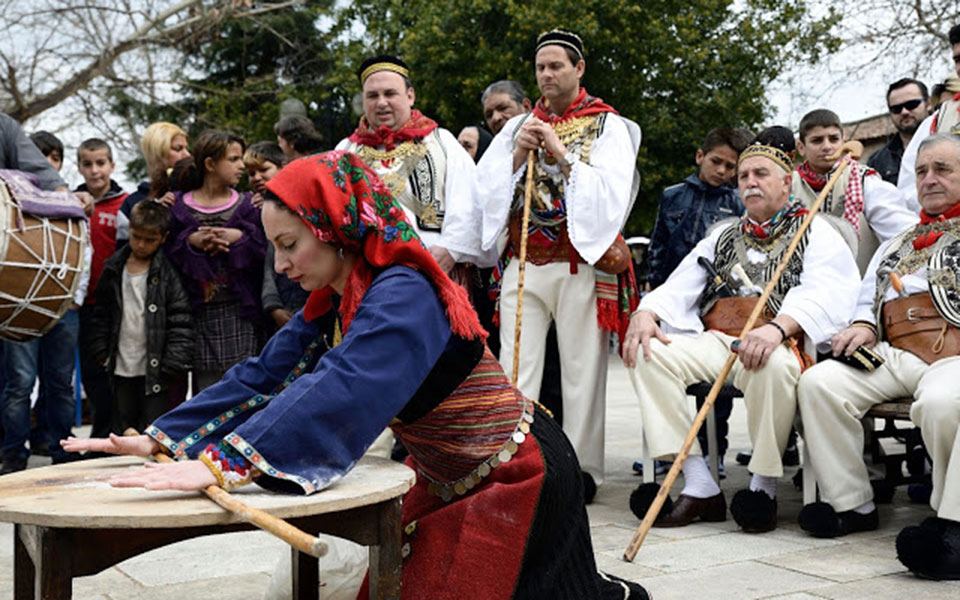
Thiva – Vlach Wedding
According to the prevailing view, the custom of the “Vlach Wedding” – a satirical re-enactment of a wedding where the role of the bride is traditionally played by a man – was brought to the town of Thiva north of Athens by Vlachs from the Pindos mountains. The custom is imbued with elements likely derived from the worship of Dionysus, such as plenty of ribald language and a playful, teasing atmosphere full of laughter.
The costumes – often authentic Vlach traditional ceremonial costumes, feature intricate embroidery and are rich in symbolism. On the last Sunday of Carnival, the “families” of the groom and bride take to the streets separately dancing and singing before meeting for the Proxenio (matchmaking) ceremony.
On Clean Monday at midday, they meet again at Thiva’s central square and the festivities get underway with music from traditional drums and flutes. Various rituals are observed – such as the shaving of the groom and the adornment of the bride, as the atmosphere grows ever more raucous and the comments from the crowd ever more bawdy.
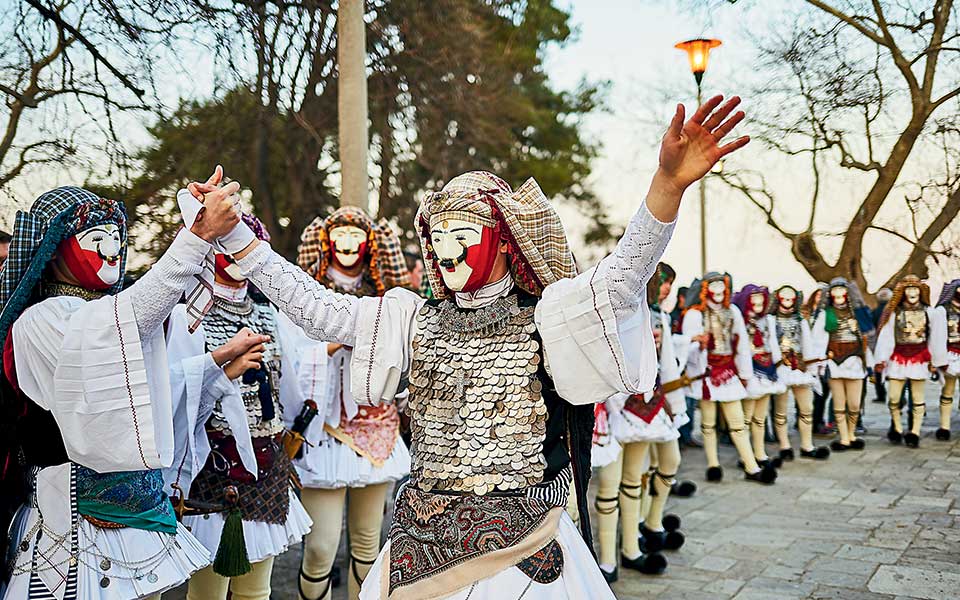
© Giorgos Tsafos
Naoussa – Meet the Genitsari
The Genitsari, the central figures of the Carnival festivities in Naoussa, are men wearing fustanellas, charms, zostres (chains), headdresses and wax or plaster masks – heirlooms which are passed down from generation to generation. The last are expressionless, serving to conceal the Genitsari’s emotions: all are equal and identical.
Alongside the Genitsari, the Boules parade through town: men again who take on the role of women, wearing colorful dresses to symbolize the coming of spring.
This ritual with ancient roots became linked more recently with the Ottoman occupation, and to this day visitors remain simple observers dressed in plain clothes.
The procession begins at 7 in the morning and passes by all the homes of the Old Town, to arrive four hours later at Alonion Square. They are accompanied by musicians playing traditional instruments, and when they arrive at the town hall they request permission from the mayor to observe the traditional custom. Then the dancing begins.
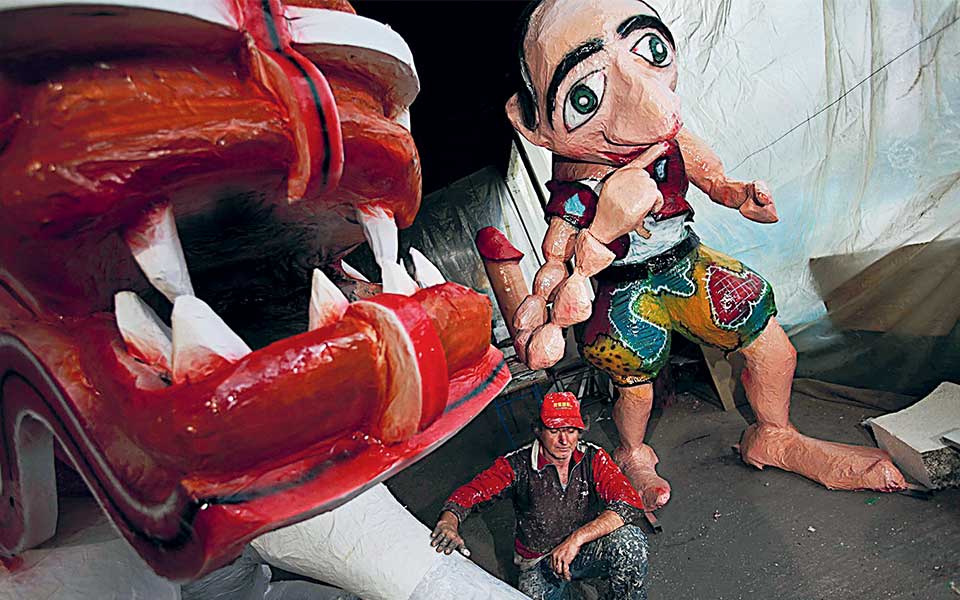
© Vangelis Kousioras/pculiar.com
Tyrnavos – Phallus front and Center
Carnival (Apokries) has always been closely associated with freedom and transcending boundaries, an ethos which is reflected in festivities full of ribald rituals, profanity, lurid songs and provocative teasing, and one that has deep Dionysian roots. Indeed in times past, the nights of masked revelry went together with a significant loosening of morals all round, with the costumes serving to keep things anonymous.
Today, throughout Greece during Carnival you will hear vulgar songs and banter, and you will see phallic objects, however this type of custom reaches its pinnacle in Bourani of the Tyrnavos region.
Here, after the carnival of the last Sunday of Apokries, the (ahem) big star emerges on Clean Monday: phalluses which emerge in the city in every possible form: balloons, souvenirs, loaves of bread, cups, and much more. Visitors to the town not only take part in the festivities, but the unwritten rule is that they must pay homage to the phallus (with a kiss no less) and, however much they may blush, bear the lewd teasing of the locals.
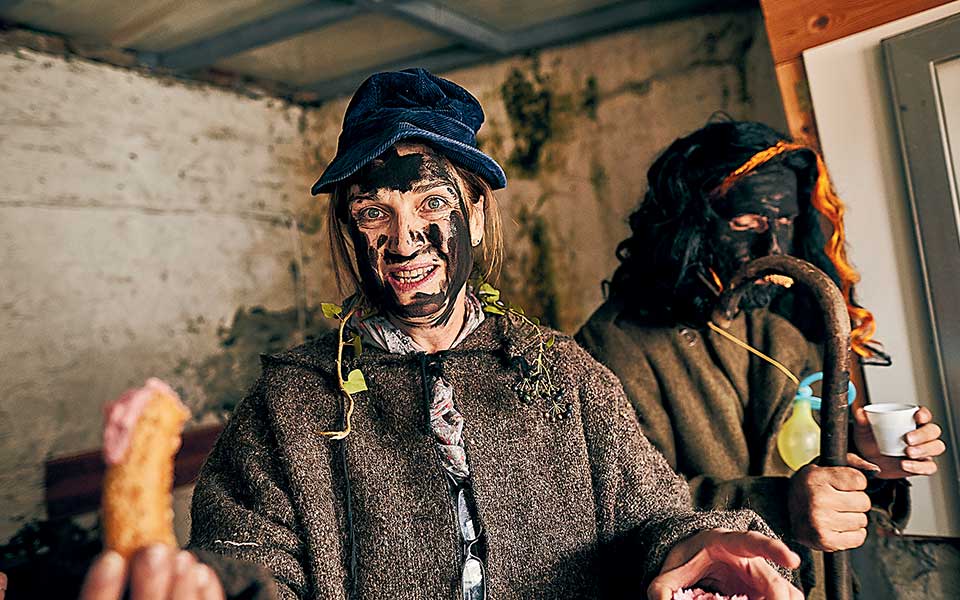
© Giorgos Tsafos
Nedousa – Evetiria
Evetiria refers to the bountifulness of the land and the harvest, and the fertility and health of people and their animals. This is precisely what the agricultural communities sought to secure through the customs observed at key points in the year, and chiefly during the transition from winter to spring.
Many of the agricultural rituals that are preserved to this day reflect many of these elements, but the most impressive is that observed in Nedousa in Messinia in the western Peloponnese. Here the three basic elements of the ritual are all represented: plowing and sowing; marriage and conception; death and resurrection.
Early in the morning on Clean Monday you will follow the Agermos, the ceremonial procession that circles the entire village and wards off evil. Many of those in the procession will have faces painted black, wear capes and will be playing drums and flutes.
The procession is followed by the Horos ton Tragon (Dance of the Billy-Goats) performed by a dance group dressed in bells and horns. Then comes the Plowing and Sowing – here participants, dressed as oxen, ‘plow’ the main square. The ritual of the Wedding and Conception takes place in an atmosphere full of lewd comments and laughter, and is followed by the ‘murder’ of the groom and a symbolic funeral.
The end of the rituals and the necessary catharsis comes with the groom’s resurrection, symbolizing the triumph of life over death and securing a bountiful harvest. The festivities then begin in earnest.

© Giorgos Tsafos
Sochos – Bonfires
Zapous are the name given to the bonfires that are lit in the village of Sochos northeast of Thessaloniki on the Saturday night before Clean Monday, around which feasts are held. They symbolize man’s attempt to ‘push’ the sun higher – i.e. to bring on the summer, and are only the beginning of the festivities that follow.
On Sunday a mock wedding is held, and the masked Arapkas make an appearance, wearing old clothes turned inside out.
On Clean Monday in the afternoon a large procession of koudounofori (“bell wearers”) is held. They are dressed impressively in goatskins overlaid with red scarves, with heavy bells hanging around their waists. Most strikingly on their heads they wear kalpakia – large headdresses decorated with foxes’ tails and colorful ribbons, that are up to a meter in height.
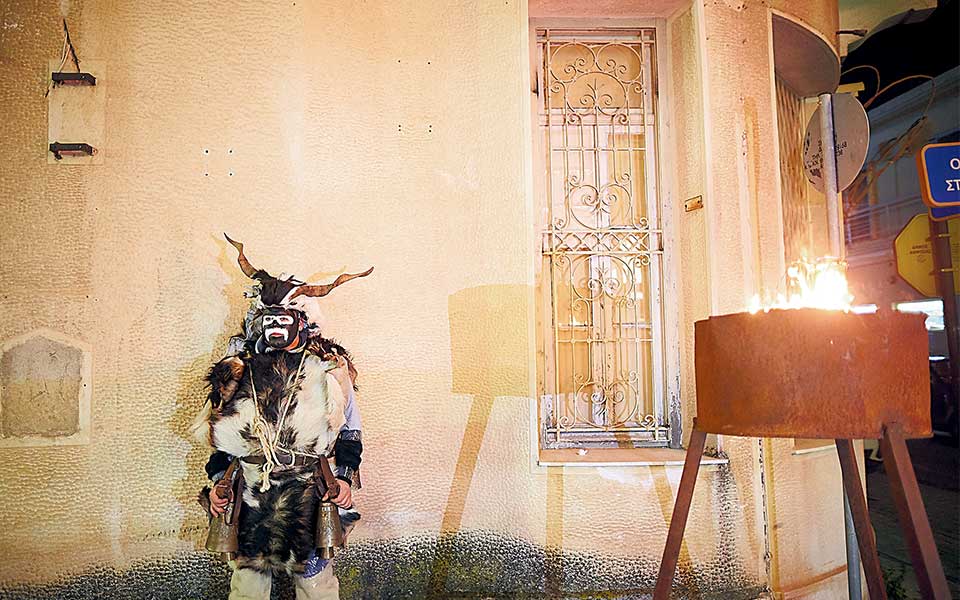
© Giorgos Tsafos
Amfissa – Night of Ghosts
Stars of the Carnival celebrations of Amfissa are tall, otherworldly human figures. The leather they wear and the bells that hang from these Stoichia (Ghosts) reflect the fact that leather tanning and bell-making were once key trades in the town.
The focus of the reenactments is the neighborhood of Harmaina, near the well where, according to legend, a girl by the name of Lenio was struck by lightning. Her longtime suitor, Konstantis, was unable to cope with her loss and committed suicide. Since then his ghost is said to have haunted the area.
The legend is now a key part of the local Carnival celebrations. On the Friday night the ritual of the “Waking of Konstantis” is held, which ‘wakes’ him and many other specters. The custom reaches its peak on Saturday with a large procession of these otherworldly figures passing through the dimly-lit streets before reaching the town’s central square.
Drama – Kalogeros
The refugees that arrived in Drama in eastern Thrace from Asia Minor brought with them the custom of the Kalogeros (Monk), which is observed in the village of Kalabaki, 12 km south of the town.
On the morning of the Monday a week before Clean Monday, all of the young people of the village gather together. One of them dresses as the Kalogeros, in animal hides and with bells around his waist. With a face blackened by soot and hidden under a hood, he cuts a frightening figure.
The noisy group goes from house to house in the village asking for treats. After visiting each house, they head to the village square where all of the residents congregate. They then mock plow the square, sow it with wheat and corn, and water the seeds – rituals tied to the agricultural way of life and which serve symbolically as good omens for a bountiful harvest. A feast is then held in the square with music and dancing.
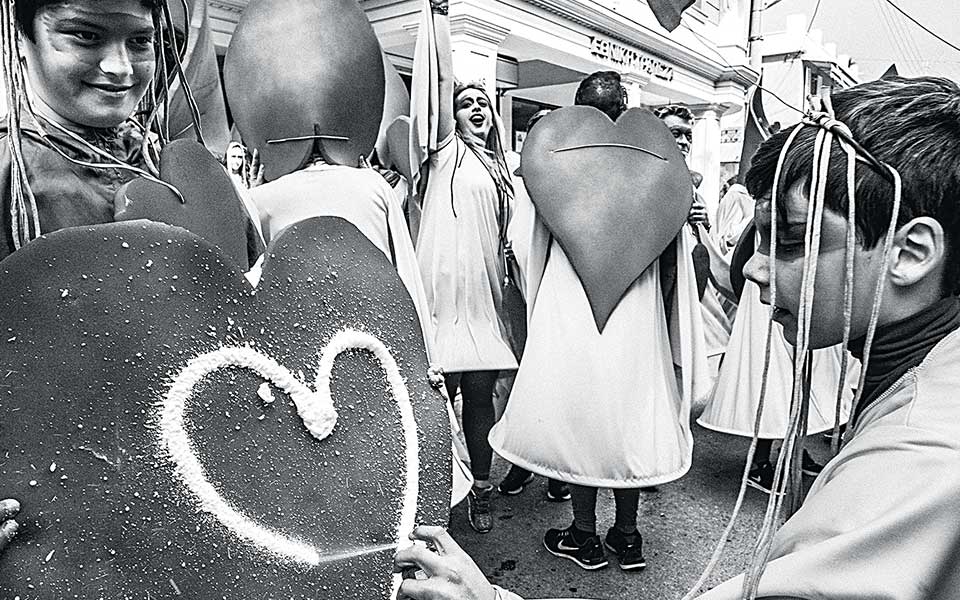
© Giorgos Tatakis/pculiar.com
Zakynthos
On Zakynthos they take Carnival celebrations particularly seriously, with local authorities beginning the planning months in advance. From the Thursday of Tsiknopempti, the celebrations begin in earnest, with residents gathering around outdoor grills that are set up all around the island. In the square of Aghios Pavlos, Carnival begins with the entrance of the figure of Konte Karnavalou to music from the local marching band.
On the Saturday of Carnival, one standout custom is the mock Venetian wedding featuring 16th-century style costumes, archers and trumpeters in Aghios Markos Square. Later the Kokkini Nichta (Red Night) parade is held where everything – costumes, balloons, confetti, fireworks – are red.
The large parade on Carnival Sunday begins at 15.00 from the church of Aghios Lazaros and lasts until about 19.30, at which point the procession for the funeral of Konte Karnavalou begins in Aghios Markos Square. There you will also see various traditional street performances.
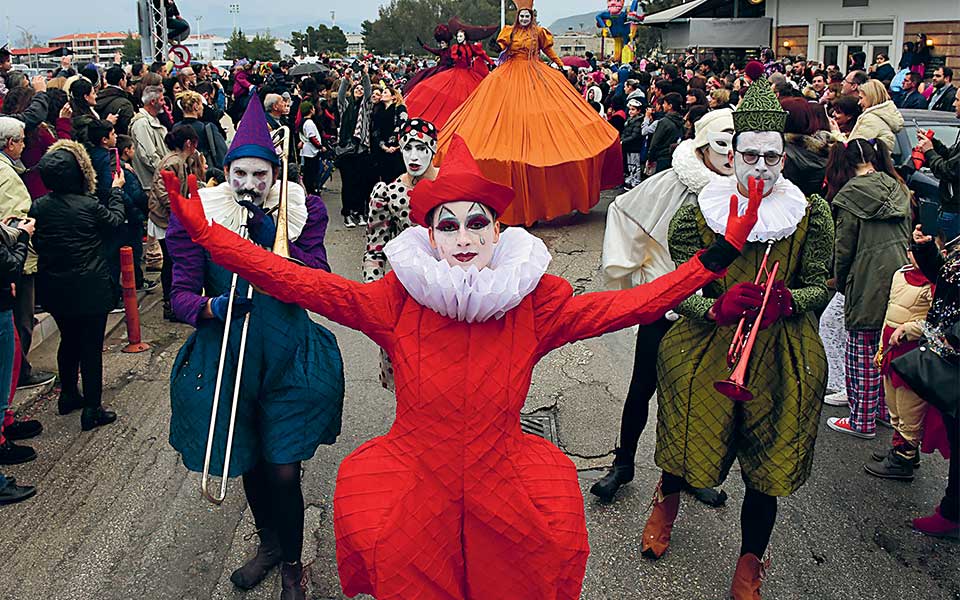
© Epa/Bougiotis Vangelis
Nafplio
It is little surprise that aristocratic Nafplio organizes one of the most stylish Carnival celebrations in the country, drawing inspiration from its Venetian past and highlighting architecture from that era, such as the famed Bourtzi fortress.
This year, on the last Saturday of Carnival, the historic center of the city will be transformed into a giant stage, with stilt walkers, drummers and theatrical performances. The celebrations culminate on the Sunday with a parade in keeping with the town’s medieval characteristics.
The traditional burning of Karnavalos (the Carnival king) takes place in Syntagma Square and is followed by concerts featuring young music groups. In the surrounding villages various local customs are observed including bonfires in the squares and plenty of local delicacies and wine for visitors.
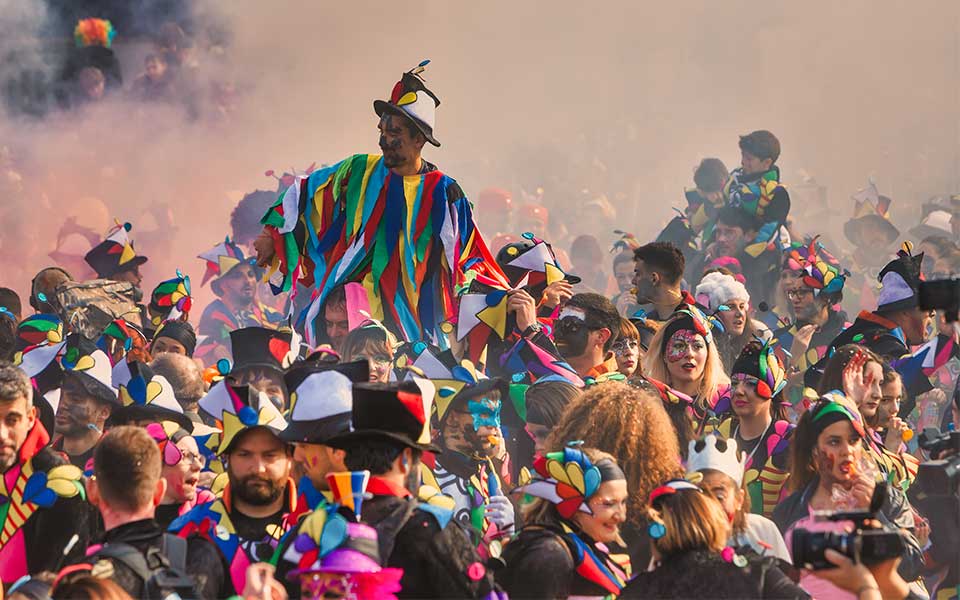
© Shutterstock
Xanthi
Every year, the town of Xanthi plays host to the largest Carnival celebrations in northern Greece. This year, the parade and associated events will have love as a central theme. Beyond the costumes and parties, it’s also worth keeping an eye out for interesting cultural events, such as book presentations, screenings and performances, many of which are organized by the highly active Progressive Union of Xanthi (FEX).
The large parade on the Sunday of Carnival begins at 13.00 – be prepared for streets packed with people. On the same day at 18:30 the action moves to the bridge over the Kosynthos river where an effigy is burnt signifying the end of Carnival.
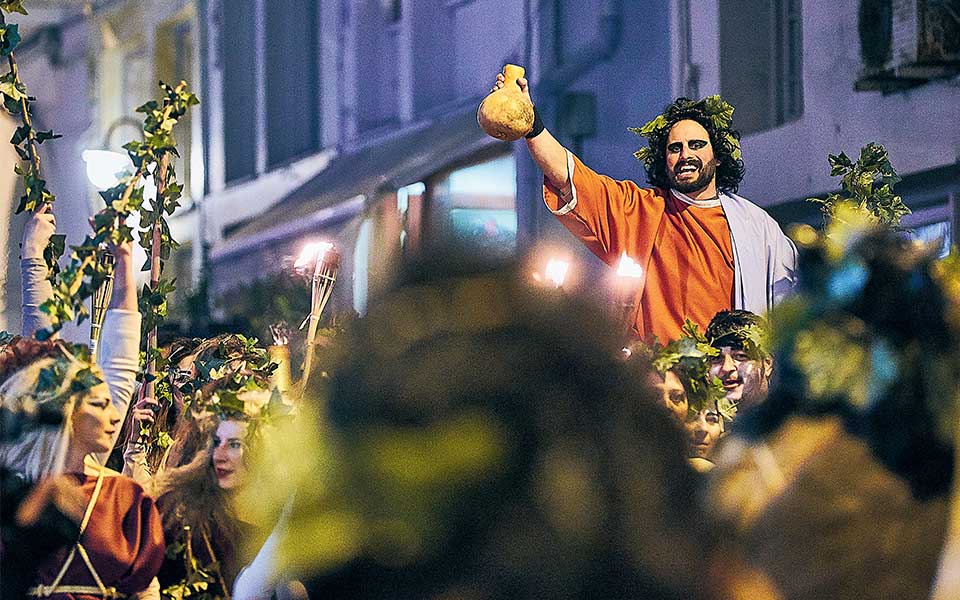
© Giorgos Tsafos
Naxos
Plowing is one of the traditional themes of the rites of Carnival, representing an appeal for a fertile soil by agricultural societies who long sought to placate fickle mother nature. While it has disappeared from most customs in Greece, like in Nedousa in the Peloponnese, in Naxos it still forms a part of Carnival customs.
The Koudounati (Bell-Wearers) of the mountain village of Apeiranthos don their capes and bells and create a racket in order to stir people and nature from their winter slumber. They re-enact the process of plowing together with rituals focused around marriage, death and resurrection.
But they are not the only attraction here. In other villages you will encounter the Kordelatous (Ribbon Wearers), aka Leventes (Warriors), who wear fustanellas and ribbons. They are said to be a reference to the pirates that would once attack the island, and they roam about mocking and teasing endlessly. In the Hora of Naxos, meanwhile, a Dionysian-style celebration is held.
Atmospheric candlelit processions, reenactments of myths and ancient rites (this year the theme is “The coming of Ariadne to Naxos and the kidnapping of Dionysus by Tyrrhenian pirates”) and ritual dances with the Portara monument as a backdrop await on the last weekend of Carnival. On the Sunday a large parade is held.
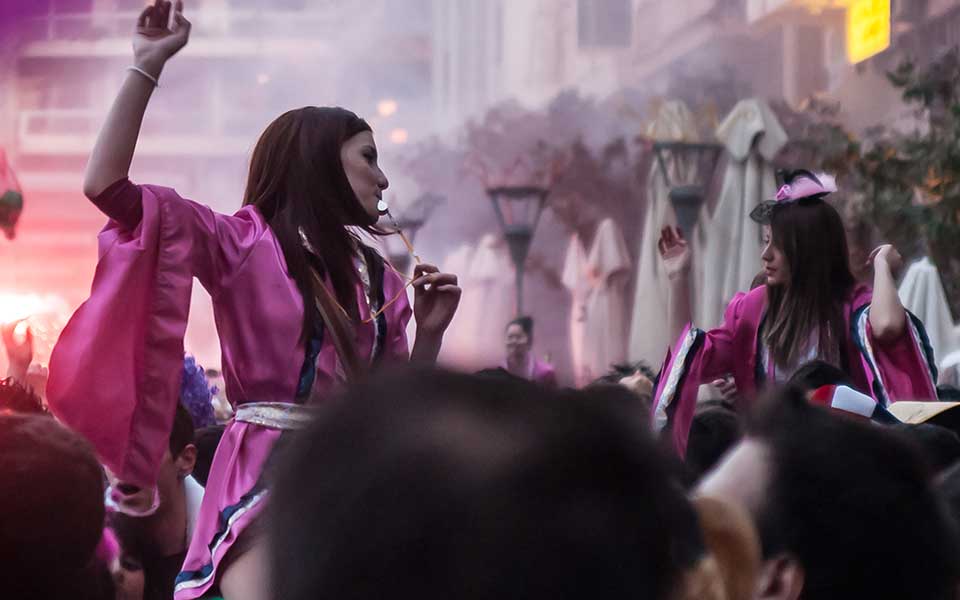
© Shutterstock
Patras
Patras is the city most closely identified with Carnival celebrations in Greece, and here the locals spend almost the entire year preparing for the season. Theatrical performances, concerts, exhibitions, dances, parades small and large for children and adults, the Satire Festival and the famed treasure hunt make Carnival the defining feature of life in the city from the very beginning of the period until Clean Monday.
This year the theme is “The Carnival that makes history and memories” and the main parade on the final Sunday of Carnival is expected to feature floats boasting special effects, while the “Flower Float” will also return after a nine year absence. After the parade the effigy of the Carnival king will be burnt on the pier of Aghios Nikolaos.
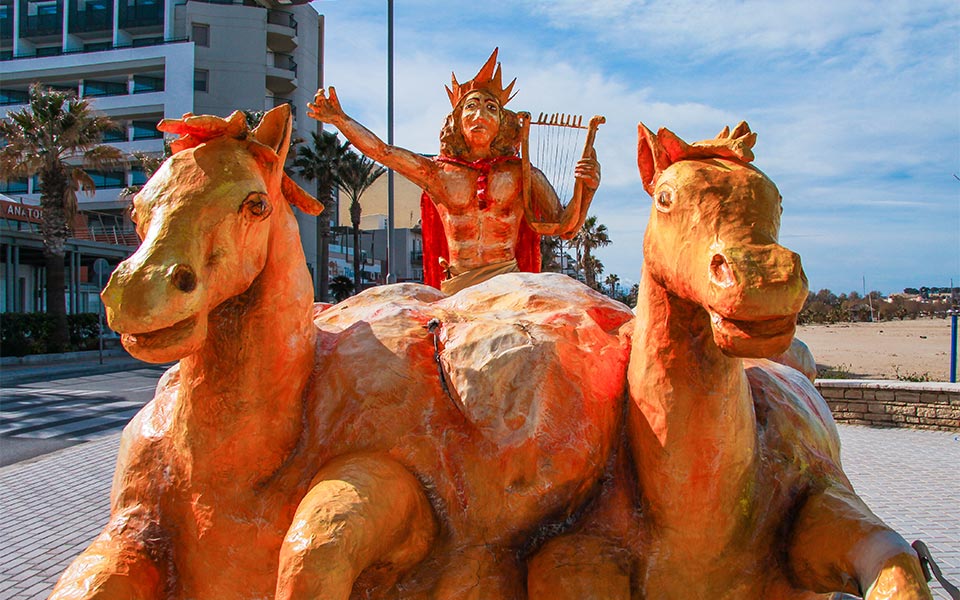
© Shutterstock
Rethymno
After Patras, the city of Rethymno can lay claim to the second most renowned parade, each year with over 100,000 visitors and over 15,000 people taking part. From the beginning of the period, the Old Town moves to the Carnival rhythm; screenings, treasure hunts, dances, traditional Cretan music, parties, costumed bike rides and more attract people from all over Crete and Greece.
The celebrations reach their pinnacle on the last weekend of Carnival. On Saturday afternoon, the children’s parade is held, and on the same day a nighttime parade. On Sunday the main parade is held with elaborately designed floats, while in the evening, on the city’s seafront, the Carnival king is set alight.
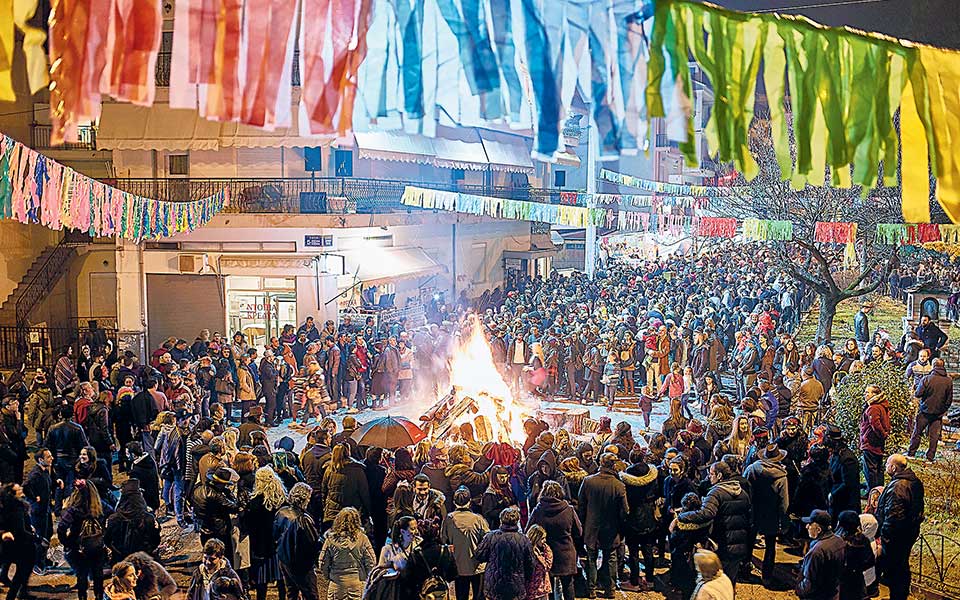
© Giorgos Tsafos
Ioannina
All around sand is spread for reasons of safety. In the center, large logs are piled; next to them are pots with fasolada (bean soup), wine, and musicians. The custom of Tzamala in Ioannina involves large bonfires which are set alight on the last Sunday of Carnival, around which feasts are held.
The fires last until the morning hours and are a form of catharsis, eliminating evil. Over 50 Tzamales are held in Ioannina and the surrounding areas, the most popular of which is held at the castle of Ioannina.
Kastoria
The Carnival bonfires mark change. On the raging fires the evils of the year are consumed, and from their ashes new things and optimism emerge. In Kastoria, children gather dry branches and store them in bundles – the valuable kindling for the great fires. On the final Sunday of Carnival the city glows with the light of many large fires which purge all demons.
The lighting of the bonfires is accompanied by brass instruments, wine and food. The most atmospheric bonfire takes place in Doltso, the traditional neighborhood with narrow lanes.
If, on the same night you happen to see an egg hanging by a string, do not be surprised – this is the custom known as Haska. The eldest of a family ties a (shelled) boiled egg to a rolling pin and holds it above the mouths of a group (who have their hands tied behind their backs). They must try to swallow the egg in three tries. Once eaten, the egg ‘shuts’ the mouth to animal products for the 40 day fast, to be reopened again on Easter Sunday – with another boiled egg.
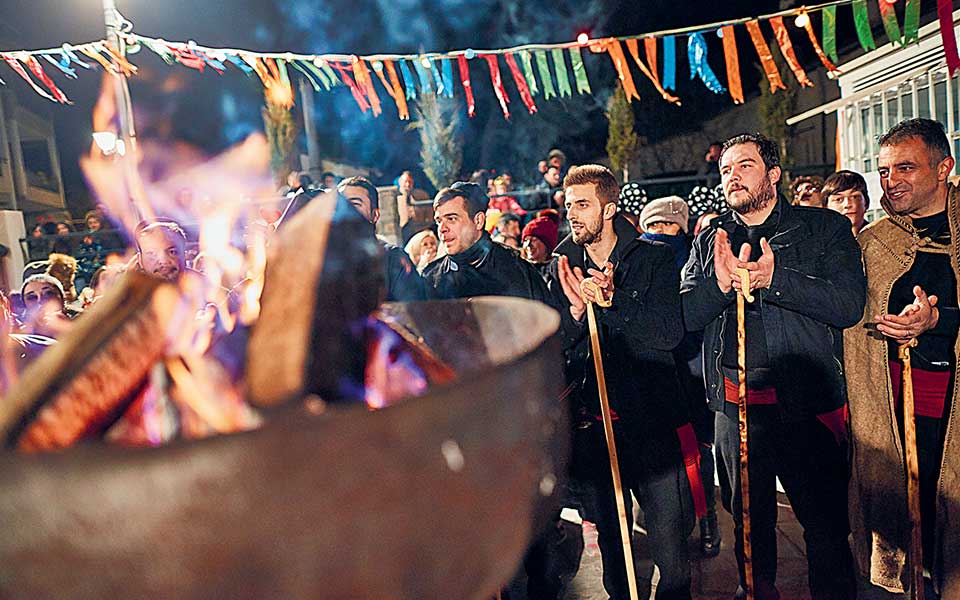
© Giorgos Tsafos
Kozani
The Carnival celebrations in Kozani last for 12 days, beginning from Tsiknopempti. The pinnacle are the Fanoi (bonfires) on the last Sunday. 15 different groups present themselves in the central square and then return to their neighborhoods to set them alight. They burn all night surrounded by feasting and dancing.
Each Fanos is located at a specific crossroads, overseen by local residents who tend to the fire, food, wine and high spirits – none of which should flag. Each Fanos also has its own brass band. Local groups dress in traditional costumes and sing songs – many of which have suggestive lyrics, in keeping with the spirit of Carnival.
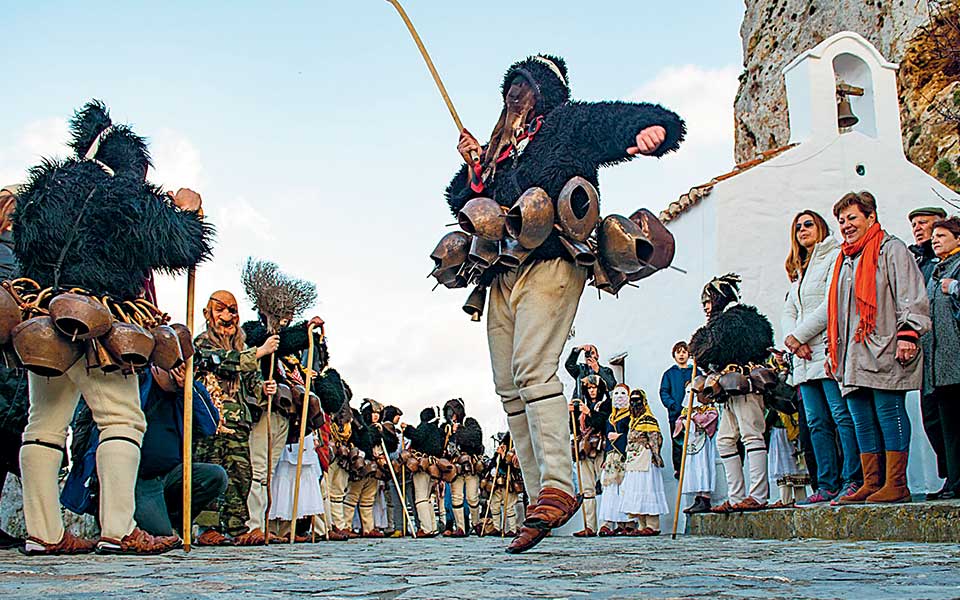
Skyros – Nautical Celebrations
The fishermen and sailors of Skyros add their own custom – the “Trata” – to the island’s Carnival celebrations, one which involves carrying a model caique to the square of the Hora at midday on the last Sunday of the season. The custom has a satirical side, with recent developments in the political and local scene fodder for witty poetic verses; it is said to be derived from similar customs in Classical Athens.
Another of Skyros’ Carnival traditions also has its roots in antiquity – that of Geros and Korela. It is said that once, when a major storm struck the island, an elderly shepherd (the Geros) watched as his animals were killed. Distraught, he hung their bells from his belt and hurried to the Hora. Behind him, also in a state of disarray, ran his wife, Korela.
Today men dressed as the Geros, rouse the island every weekend on Carnival. Numerous bells weighing in total up to 50 kilos hang from their waists, and they wear the black traditional shepherds’ cloaks backwards. Each Geros is accompanied by a masked Korela – typically a man dressed in traditional women’s garb. They move rhythmically and the sound of the bells lend a primal atmosphere to the island.
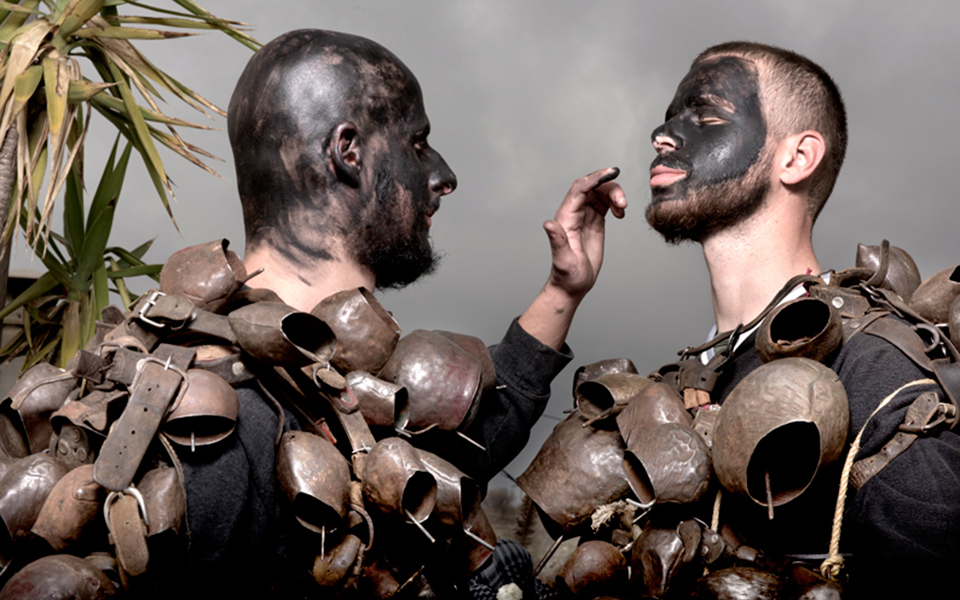
© Dimitris Geros
Serres and Lesvos – An Ode to Nature
Essentially the rites of Carnival are odes to nature, appeals for it to awaken. These are more or less obvious in different locales with animalistic costumes and bells common themes.
Among the most characteristic customs are those of the Babougeroi in Serres and on the island of Lesvos.
On Carnival Sunday and Clean Monday in the village of Flambouro in Serres, the Babougeroi – wearing sheepskins, conical headdresses filled with beads, kerchiefs and multicolored ribbons – dance ceaselessly ringing their bells. They carry oranges, which people wedge coins into – a symbol of forgiveness (the coins are later donated to the church).
In the village of Mesotopos on Lesvos, shepherds hang bells from their their belts, blacken their faces and wear traditional scarves or hats made out of gourds and rooster and turkey feathers.
The bell-wearers strike the ground with phallic rods in order to awaken it, while processions are led by the Geros (Old Man) dressed in full body white underwear on which a phallus is drawn. After they pass through the entire village, the celebrations are kicked off with a suggestive traditional dance between two men in traditional dress.

